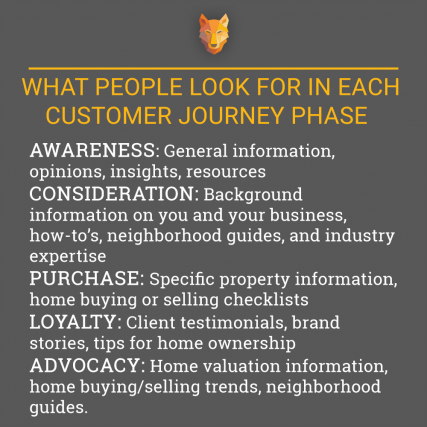You are viewing our site as an Agent, Switch Your View:
Agent | Broker Reset Filters to Default Back to ListHow to Use Your Real Estate Blog for Lead Nurturing
September 04 2018
 Lead nurturing--consistent and targeted communications that move your leads further down the customer journey--is a necessary part of any successful marketing campaign. A study by Forrester has shown that marketers see an average 20 percent increase in sales opportunities from nurtured vs non-nurtured leads, meaning if you aren't doing lead nurturing now, you should be.
Lead nurturing--consistent and targeted communications that move your leads further down the customer journey--is a necessary part of any successful marketing campaign. A study by Forrester has shown that marketers see an average 20 percent increase in sales opportunities from nurtured vs non-nurtured leads, meaning if you aren't doing lead nurturing now, you should be.
One of the best resources a real estate agent has to nurture their leads is their blog—it's the perfect place to publish your real estate knowledge that targets every phase of the customer journey. We'll walk you through developing targeted blog content, distributing it to your leads, and how to start marketing automation for a strong lead nurturing campaign.
Match Your Goals
Before you jump into optimizing or creating lead nurturing blog content, you should take a look at your current blog goals. What are you using your blog for and why? This answer might look different depending on how long you've been in real estate. For example, new agents might use their blog to drive awareness while expert agents use theirs to promote their experience and neighborhood knowledge. Whatever the purpose, understand that lead nurturing can be a part of it as long as you focus on your leads and their experiences and don't hold onto conflicting goals.
An example of a conflicting blog goal with lead nurturing: "I use my blog to only promote my home listings." This doesn't fit with lead nurturing—a constant, ongoing process that requires you to create blogs that work for different stages of the customer journey, not just the "Purchase" phase. To fix this example, you might re-evaluate your overall blog goal and change it to "I use my blog to promote my home-buying tips, checklists, and home listings," a broader goal that has plenty of room for lead nurturing content within it.
Creating Targeted Content
Targeted content is content that is written to be read by a specific audience at a certain stage of the customer journey. Targeted content is the backbone of using your blog for lead nurturing. With a blog full of target content, you create multiple points for leads to enter your system at any stage of the customer journey.
Client Personas
To begin creating targeted content, check back to your marketing personas—use these profiles of your clients' and potential clients' needs, wants, and preferences to create content that fits what they need when they are looking to work with a real estate agent. Analyze the research behind them to figure out: what are my customers looking for at different stages of their customer journey? What are their questions, problems, and where could they use your guidance? Remember that you still need to provide real, insightful information for your blog to be successful. Readers don't want a sales pitch with no benefit to them.
Use your persona data to segment potential blog topics into groups that align with the customer journey while keeping in mind what they might be searching for in their home buying or selling process. This process is known as "content mapping," and we explain the different types of content your leads might be looking for throughout their real estate journey:

Learn more about creating customer journey-centric messages in our Real Estate Marketing 101 Ebook.
Real-World Insights
Power up your persona-driven content by asking your real-life clients and connections questions that will help you reveal more about their needs, intentions, and wants. Start with open-ended questions without yes or no answers to get great insights about their challenges.
- What was the most difficult part of buying/selling a home?
- What tips were the most helpful during your journey?
- What did you research online when you were looking for a property?
These answers can help you shape the questions you answer and the challenges or successes you highlight in your blog, as well as fill in any gaps in your existing content by adding depth and purpose to your blogs.
Keyword Research
Go granular and dig deep into some keyword research. Optimizing your posts for search engines, known as SEO, is a great way to ensure that when your leads search your brand name or topics they have questions about that your blog comes up. This is a great tactic to prove your blog's relevance—when a blog shows up on the front page of Google, it makes it stand out.
Use one of these free tools to find out what your leads are searching for. You might find that the keywords your audience are searching for are different than the keywords you have been including on your site. Try switching out keywords on a few of your blogs or writing new blogs that feature those keywords to test if your audience is more receptive to the new keywords versus your existing keywords.
Integrating these three facets of targeted content—personas, answers from your clients, and keyword research pays off: you now have the means to write and distribute targeted content, created specifically for your audiences and their place in the customer journey.
Distribution: Sending the Right Message
After all of this hard work creating content targeted for your audience, you have to find a way to get it to them at the right time and place—this is where email, social media, and marketing automation come in.
Email Campaigns
Targeted email campaigns are one of the most popular methods for lead nurturing, mainly because lead nurturing emails get 4-10 times the response rate compared to standalone email blasts. When your emails are part of a coherent story that is sent at the right time for your customer, your click-through rates go up. People like thoughtful emails that aren't sent at random, but are sent when they inquire about a listing or have subscribed.
Tip: Learn how to design eye-catching email templates to support your lead nurturing strategy in our blog, 4 Tips for Creating Your Branded Real Estate Email Template.
To create great email lead nurturing campaigns using your blog content:
- Set objectives and goals for each email
- Narrow down which kinds of messages will go to each type of persona at all the stages of the customer journey
- Set up timelines for your campaigns
- How often should someone receive an email from you? How many messages should you send them?
- Assess your progress
- Check in—which type of headlines, layouts, and CTAs work best for your audiences? Never be afraid to switch things up and change your campaigns to see better results.
Social Media
Shorten your blog messages into digestible tidbits for social and promote your blogs there. Consistency is key with social media: your leads and potential leads want to see your content shared on a regular basis. Because social media is heavily visual, you can feel free to do more targeting with images and video rather than text here.
Tip: Get the full story on social media lead nurturing in our blog, How to Connect With Your Leads on Social Media.
Marketing Automation
The next marketing frontier for many real estate agents, marketing automation allows you, through applications and software, to track and send targeted messages to leads at specific times. Combined with lead-capturing technology on your real estate website, marketing automation makes it a lot simpler for you to execute targeted distribution campaigns through email and social to get your blogs to the right people. Of course, you still have to write your blogs and your email campaigns, but now you don't have to schedule them yourself—a program can do that.
Read our blog How to Leverage Automation for Lead Nurturing to get started with marketing automation.
Through targeted content and thoughtful distribution, your wealth of real estate knowledge becomes a tool for guiding leads through the phases of the customer journey and converting them into paying clients (and back again for repeat business).
To view the original article, visit the WolfNet blog.









